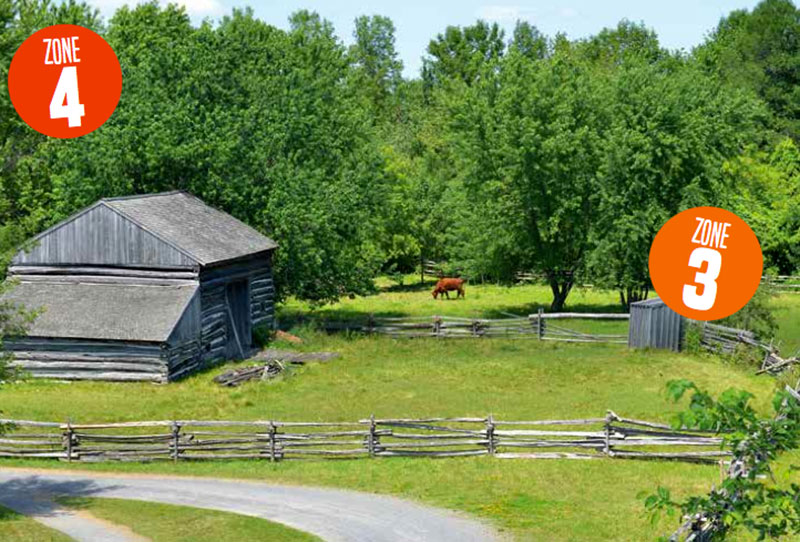
What if your farm operated in a way that completely mimicked nature? What if there was no waste but only abundance? What if everything you did thrived on free solar income, not fossil fuels, and you were sheltered by a house made with materials found on site? This is no fantasy or pipe dream. It’s called permaculture.
Coined by Bill Mollison and David Holmgren in Australia in the 1970s, the term is a melding of two words—permanent and culture—and a set of ethics and principles to guide how we, as humans, can live with the natural cycles and processes of nature. This holistic approach is perfectly suited to hobby farmers, regardless of the size or scope of our operations.
Permaculture as a practice involves turning your farm into a diverse, ecologically interconnected web of plants and animals that sustains—if not also restores—the very fabric of a healthy, viable community of life. Many permaculture practices are familiar to hobby farmers, such as organic farming, natural building, composting, recycling and renewable energy. “Permaculture is the toolbox that helps us organize and decide when and how to use those tools,” writes Toby Hemenway in Gaia’s Garden (Chelsea Green, 2001).
There are five basic steps to implementing a permaculture design on your own farm. The first four involve pencil and paper—ideal for the off-season, when there are fewer farm demands.
Step 1: Observe
Walk the land, making lists, drawing maps and noting present elements and the interactions they have with other farm features. You’ve most likely completed a soil test, but in this step, you’ll need to dig a lot deeper to sort out and inventory all the trees, plants and nuances of the land, such as a warm zone (microclimate) against one of your outbuildings.
Step 2: Envision
Complete a “needs versus yield” analysis while addressing any limitations and resources you might have. On our farm, we wanted to be largely self-sufficient in food production and to over-produce electricity from renewable sources—in essence, becoming fossil-fuel free. Your vision might be different than ours, and it still can be achieved through permaculture design. Knowing this upfront will help you focus your design on the elements that suit your farming goals and budgets in the long run.
Step 3: Plan
This step involves both conceptual design considerations (personal, ecological and aesthetic) and schematic design (the plants, animals, structures, functions and other aspects). When planning, ask yourself a number of questions to help you think through the farm’s sustainability:
- Can the needs of one design element be met by another?
- How do seasonality, sunlight and water access play into your design?
“Getting outside the box of what we think is normal farming could be the hardest [part]. We must examine the ‘sacred cows’ of our culture and what we think we need,” says Bill Wilson, who, with his wife, Becky, co-founded Midwest Permaculture, a home-based regional business providing intensive permaculture courses and a plethora of resources on its website. “One of the biggest drawbacks to a hobby farm is the focus on a single family. The human element must be included in the whole-system planning and thinking, questioning the need we have for owning one of everything. A small community or extended family can minimize purchases and share assets, tools, knowledge, and labor and benefit from the joy of friendship and sharing the richness of life.”
Step 4: Develop
After extensive research into the species and crop varieties you want to include in your design, synthesize and formalize all your lists and notes into a sketch. You can easily download a picture of your farm online, using a program such as Google Earth.
Step 5: Implement
Turn your paper dream into reality. Remain flexible and adaptable, should everything not turn out just as you planned. Like nature, be opportunistic.
Permaculture Planting Zones
Zone 1
This area is closest to the house and is used most frequently. It includes annual gardens, greenhouses, small compost or worm farms, and labor-intensive crops.
Zone 2
This area is not as close, is used less frequently and includes perennials and vegetables with long growing seasons, fruit trees, large compost bins, beehives, ponds, coops and other livestock areas.
Zone 3
This area is less-frequently accessed and includes larger trees and farming crops, pastures and areas for animal forage.
Zone 4
This area is mostly wild with some management and might include areas for collecting wild foods and timber production or provide a source of foraging for livestock and pasture for grazing animals.
This article appeared in Living Off the Grid, a 2018 specialty publication produced by the editors and writers of Hobby Farms magazine. Aside from this piece on permaculture, Living Off the Grid includes stories on renewable energy, growing plants without seeds and long-term storage of produce. You can purchase this volume, Hobby Farms back issues as well as special editions such as Best of Hobby Farms and Best of Urban Farm by following this link.




